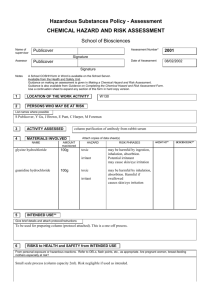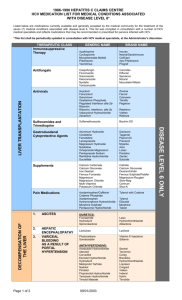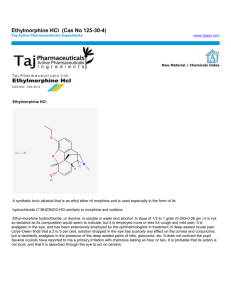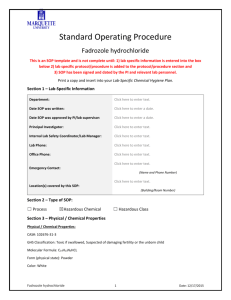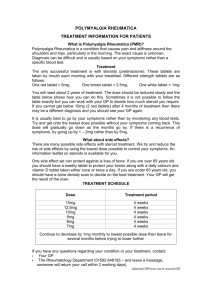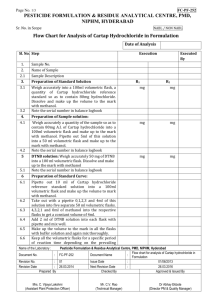Neosynephrine
advertisement
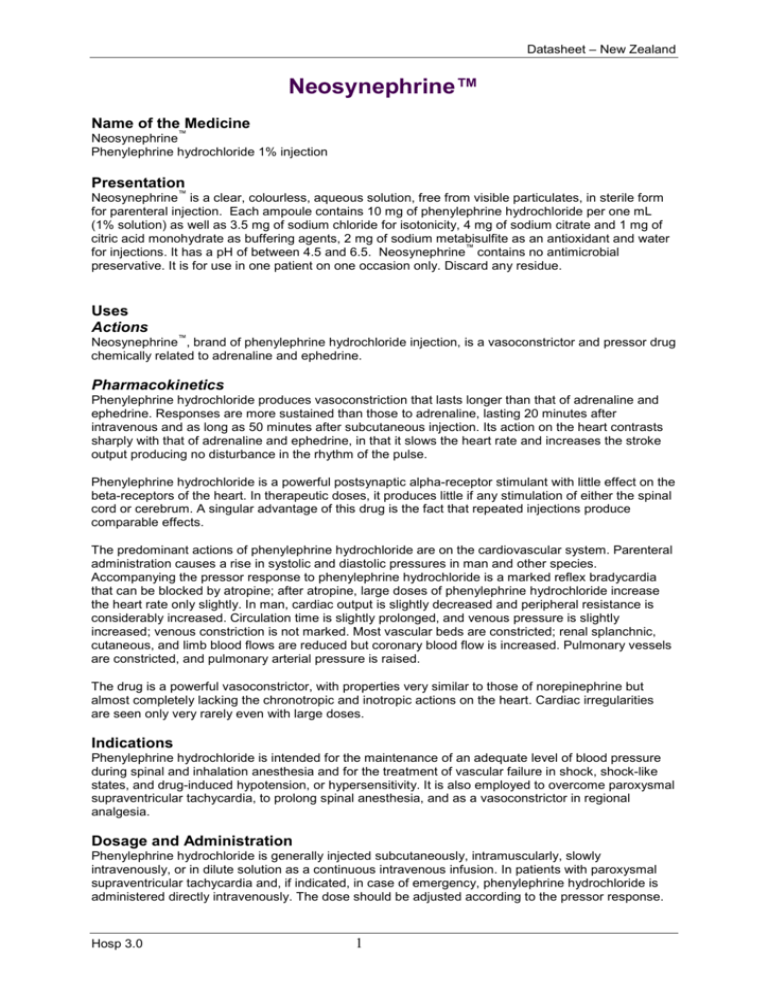
Datasheet – New Zealand Neosynephrine™ Name of the Medicine ™ Neosynephrine Phenylephrine hydrochloride 1% injection Presentation ™ Neosynephrine is a clear, colourless, aqueous solution, free from visible particulates, in sterile form for parenteral injection. Each ampoule contains 10 mg of phenylephrine hydrochloride per one mL (1% solution) as well as 3.5 mg of sodium chloride for isotonicity, 4 mg of sodium citrate and 1 mg of citric acid monohydrate as buffering agents, 2 mg of sodium metabisulfite as an antioxidant and water ™ for injections. It has a pH of between 4.5 and 6.5. Neosynephrine contains no antimicrobial preservative. It is for use in one patient on one occasion only. Discard any residue. Uses Actions ™ Neosynephrine , brand of phenylephrine hydrochloride injection, is a vasoconstrictor and pressor drug chemically related to adrenaline and ephedrine. Pharmacokinetics Phenylephrine hydrochloride produces vasoconstriction that lasts longer than that of adrenaline and ephedrine. Responses are more sustained than those to adrenaline, lasting 20 minutes after intravenous and as long as 50 minutes after subcutaneous injection. Its action on the heart contrasts sharply with that of adrenaline and ephedrine, in that it slows the heart rate and increases the stroke output producing no disturbance in the rhythm of the pulse. Phenylephrine hydrochloride is a powerful postsynaptic alpha-receptor stimulant with little effect on the beta-receptors of the heart. In therapeutic doses, it produces little if any stimulation of either the spinal cord or cerebrum. A singular advantage of this drug is the fact that repeated injections produce comparable effects. The predominant actions of phenylephrine hydrochloride are on the cardiovascular system. Parenteral administration causes a rise in systolic and diastolic pressures in man and other species. Accompanying the pressor response to phenylephrine hydrochloride is a marked reflex bradycardia that can be blocked by atropine; after atropine, large doses of phenylephrine hydrochloride increase the heart rate only slightly. In man, cardiac output is slightly decreased and peripheral resistance is considerably increased. Circulation time is slightly prolonged, and venous pressure is slightly increased; venous constriction is not marked. Most vascular beds are constricted; renal splanchnic, cutaneous, and limb blood flows are reduced but coronary blood flow is increased. Pulmonary vessels are constricted, and pulmonary arterial pressure is raised. The drug is a powerful vasoconstrictor, with properties very similar to those of norepinephrine but almost completely lacking the chronotropic and inotropic actions on the heart. Cardiac irregularities are seen only very rarely even with large doses. Indications Phenylephrine hydrochloride is intended for the maintenance of an adequate level of blood pressure during spinal and inhalation anesthesia and for the treatment of vascular failure in shock, shock-like states, and drug-induced hypotension, or hypersensitivity. It is also employed to overcome paroxysmal supraventricular tachycardia, to prolong spinal anesthesia, and as a vasoconstrictor in regional analgesia. Dosage and Administration Phenylephrine hydrochloride is generally injected subcutaneously, intramuscularly, slowly intravenously, or in dilute solution as a continuous intravenous infusion. In patients with paroxysmal supraventricular tachycardia and, if indicated, in case of emergency, phenylephrine hydrochloride is administered directly intravenously. The dose should be adjusted according to the pressor response. Hosp 3.0 1 Datasheet – New Zealand Dosage Calculations Dose Required Use Neo-Synephrine 1% 10 mg 1 mL 5 mg 0.5 mL 1 mg 0.1 mL For convenience in intermittent intravenous administration, dilute 1mL Neo-Synephrine 1% with 9mL Sterile Water for Injection, to yield 0.1% phenylephrine hydrochloride. Dose Required Use Diluted Neo-Synephrine (0.1%) 0.1 mg 0.1 mL 0.2 mg 0.2 mL 0.5 mg 0.5 mL Mild or Moderate Hypotension Subcutaneously or Intramuscularly Usual dose, from 2mg to 5mg. Range, from 1mg to 10mg. Initial dose should not exceed 5mg. Intravenously Usual dose, 0.2mg. Range, from 0.1mg to 0.5mg. Initial dose should not exceed 0.5 mg. Injections should not be repeated more often than every 10 to 15 minutes. A 5mg intramuscular dose should raise blood pressure for one to two hours. A 0.5mg intravenous dose should elevate the pressure for about 15 minutes. Severe Hypotension and Shock - Including Medicine-Related Hypotension Blood volume depletion should always be corrected as fully as possible before any vasopressor is administered. When, as an emergency measure, intra-aortic pressures must be maintained to prevent cerebral or coronary artery ischemia, phenylephrine hydrochloride can be administered before and concurrently with blood volume replacement. Hypotension and occasionally severe shock may result from overdosage or idiosyncrasy following the administration of certain drugs, especially adrenergic and ganglion blocking agents, rauwolfia and veratrum alkaloids, and phenothiazine tranquilizers. Patients who receive a phenothiazine derivative as preoperative medication are especially susceptible to these reactions. As an adjunct in the management of such episodes, phenylephrine hydrochloride is a suitable agent for restoring blood pressure. Higher initial and maintenance doses of phenylephrine hydrochloride are required in patients with persistent or untreated severe hypotension or shock. Hypotension produced by powerful peripheral adrenergic blocking agents, chlorpromazine, or pheochromocytomectomy may also require more intensive therapy. Continuous Infusion Add 10mg of the drug (1mL of 1 %solution) to 500mL of Dextrose 5% Injection, or Sodium Chloride 0.9% Injection (providing a 1:50,000 solution equivalent to 20 micrograms per mL). To raise the blood pressure rapidly, start the infusion at about 100 micrograms to 180 micrograms per minute (based on 20 drops per mL this would be 100 to 180 drops per minute). When the blood pressure is stabilized (at a low normal level for the individual), a maintenance rate of 40 micrograms to 60 micrograms per minute usually suffices (based on 20 drops per mL this would be 40 to 60 drops per minute). If the drop size of the infusion system varies from the 20 drops per mL, the dose must be adjusted accordingly. If a prompt initial pressor response is not obtained, additional increments of phenylephrine hydrochloride (10mg or more) are added to the infusion bottle. The rate of flow is then adjusted until the desired blood pressure level is obtained. (In some cases, a more potent vasopressor, such as norepinephrine bitartrate, may be required.) Hypertension should be avoided. The blood pressure Hosp 3.0 2 Datasheet – New Zealand should be checked frequently. Headache and/or bradycardia may indicate hypertension. Arrhythmias are rare. Spinal Anesthesia-Hypotension Routine parenteral use of phenylephrine hydrochloride has been recommended for the prophylaxis and treatment of hypotension during spinal anesthesia. It is best administered subcutaneously or intramuscularly three or four minutes before injection of the spinal anesthetic. The total requirement for high anesthetic levels is usually 3mg, and for lower levels, 2mg. For hypotensive emergencies during spinal anesthesia, phenylephrine hydrochloride may be injected intravenously, using an initial dose of 0.2 mg. Any subsequent dose should not exceed the previous dose by more than 0.1mg to 0.2mg and no more than 0.5mg should be administered in a single dose. To combat hypotension during spinal anesthesia in children, a dose of 0.5mg to 1mg per 25 pounds (approx 11 kg) body weight, administered subcutaneously or intramuscularly, is recommended. Prolongation of Spinal Anesthesia The addition of 2mg to 5mg of phenylephrine hydrochloride to the anesthetic solution increases the duration of motor block by as much as approximately 50 percent without any increase in the incidence of complications such as nausea, vomiting, or blood pressure disturbances. Vasoconstrictor for Regional Analgesia Concentrations about ten times those employed when adrenaline is used as a vasoconstrictor are recommended. The optimum strength is 1:20,000 (equivalent to 50 micrograms per mL) made by adding 1 mg of phenylephrine hydrochloride to every 20mL of local anesthetic solution. Some pressor responses can be expected when 2mg or more are injected. Paroxysmal Supraventricular Tachycardia Rapid intravenous injection (within 20 to 30 seconds) is recommended; the initial dose should not exceed 0.5mg, and subsequent doses, which are determined by the initial blood pressure response, should not exceed the preceding dose by more than 0.1mg to 0.2mg, and should never exceed 1mg. Contraindications Phenylephrine hydrochloride should not be used in patients with severe hypertension, ventricular tachycardia, or in patients who are hypersensitive to it. Warnings and Precautions If used in conjunction with oxytocic drugs, the pressor effect of sympathomimetic pressor amines is potentiated (see Interactions). The obstetrician should be warned that some oxytocic drugs may cause severe persistent hypertension and that even a rupture of a cerebral blood vessel may occur during the postpartum period. Contains sodium metabisulfite, a sulfite that may cause allergic-type reactions including anaphylactic symptoms and life-threatening or less severe asthmatic episodes in certain susceptible people. The overall prevalence of sulfite sensitivity in the general population is unknown and probably low. Sulfite sensitivity is seen more frequently in asthmatic than in nonasthmatic people. General Phenylephrine hydrochloride should be employed only with extreme caution in elderly patients or in patients with hyperthyroidism, bradycardia, partial heart block, myocardial disease, or severe arteriosclerosis . Carcinogenesis and mutagenesis No long-term animal studies have been done to evaluate the potential of phenylephrine hydrochloride in these areas. Pregnancy and Lactation Use in pregnancy Animal reproduction studies have not been conducted with phenylephrine hydrochloride. It is also not known whether phenylephrine hydrochloride can cause fetal harm when administered to a pregnant woman or can affect reproduction capacity. Phenylephrine hydrochloride should be given to a pregnant woman only if clearly needed. Hosp 3.0 3 Datasheet – New Zealand It is not known whether this medicines excreted in human milk. Because many are excreted in human milk, caution should be exercised when phenylephrine hydrochloride is administered to a nursing woman. Use in Labour and Delivery If vasopressor drugs are either used to correct hypotension or added to the local anesthetic solution, the obstetrician should be cautioned that some oxytocic drugs may cause severe persistent hypertension and that even a rupture of a cerebral blood vessel may occur during the postpartum period. Paediatric Use To combat hypotension during spinal anesthesia in children, a dose of 0.5mg to 1mg per 25 pounds (approx. 11 Kg) body weight, administered subcutaneously or intramuscularly, is recommended. Adverse Effects Headache, reflex bradycardia, excitability, restlessness, and rarely arrhythmias. Interactions Vasopressors, particularly metaraminol, may cause serious cardiac arrhythmias during halothane anesthesia and therefore should be used only with great caution or not at all. Oxytocic medicines: The pressor effect of sympathomimetic presssor amines is potentiated (see Warnings and Precautions). MAO Inhibitors: The pressor effect of sympathomimetic pressor amines is markedly potentiated in patients receiving monoamine oxidase inhibitors (MAOI). Therefore, when initiating pressor therapy in these patients, the initial dose should be small and used with due caution. The pressor response of adrenergic agents may also be potentiated by tricyclic antidepressants. Overdosage Overdosage may induce ventricular extrasystoles and short paroxysms of ventricular tachycardia, a sensation of fullness in the head and tingling of the extremities. Should an excessive elevation of blood pressure occur, it may be immediately relieved by an αadrenergic blocking agent, e.g., phentolamine. The oral LD 50 in the rat is 350mg/kg, in the mouse 120mg/kg. In case of overdose, immediately contact the Poisons Information Centre for advice (in New Zealand call 0800 764 766). Pharmaceutical Precautions Protect from light if removed from the packaging. Store below 25°C. Medicine Classification Prescription Medicine Package Quantities Presented in amber clamshells each containing 5 ampoules. Five packs of five (5) ampoules are shrink-wrapped to form packs of 25 ampoules. Further Information Phenylephrine hydrochloride is a synthetic sympathomimetic agent in sterile form for parenteral injection. Chemically, phenylephrine hydrochloride is (-)-m-Hydroxy-α-[(methylamino) methyl] benzyl alcohol hydrochloride, and has the following structural formula: Hosp 3.0 4 Datasheet – New Zealand It is a white or almost white crystalline powder, freely soluble in water and alcohol. The air in all ampoules has been displaced by nitrogen gas. Name and Address Hospira NZ Limited 58 Richard Pearse Drive Airport Oaks, Mangere 2022 Auckland New Zealand Date of Preparation 19 December 2014 Hosp 3.0 5
